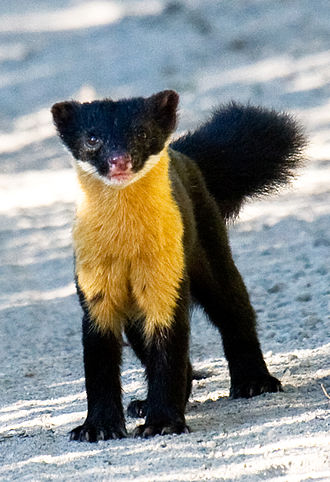In Coimbatore District of Tamil Nadue lies Valparai Shola National Park. Its undulating terrain, filled with the shola grasslands and temperate forests trees, forms the ideal habitat for several animals endemic species. One of them is the Nilgiri marten (Martes gwatkinsii), a member of the taxa which includes badgers and weasels.

The Biology of Nilgiri Martens
Physical Characteristics
Nilgiri martens average around 2.1 kg. Their body lengths are anywhere from 55 to 65 cm, with their tail length being anywhere from 40 to 45 cm. As a marten, they have a high basal metabolic rate. Their coat color is brown with a very distinct yellow or orange throat patch. Nilgiri martens are similiar in size and appearance to yellow throated martens. However, the former species are distinguished by a larger size and flattened braincases with a prominent frontal concavity.
Reproduction
The reproductive habits of the Nilgiri martens have not been studied. Being the closest relative of yellow throated martens,Nilgiri martens possibly share numerous biological and behavioral traits. Therefore it is believed that Nilgiri martens are also monogamous. Yellow throated martens breed between either February and March or between June and August. Nilgiri martens may follow a similar reproductive schedule. Gestation periods of yellow-throated martens last between 220 and 290 days.
Lifespan
The lifespan of Nilgiri martens is currently unknown. However, yellow throated martens, have been known to live on average 14 years in captivity. Additionally, other martens have been known to live on average 10 to 18.1 years in captivity.
What is the ecology of the Nilgiri Marten?
Nilgiri martens are thought to be diunral and mostly arboreal expect while hunting and foraging. The species is thought to be fairly social. It has been seen interacting and even hunting in groups. Similar to closely related species, Nilgiri Martens likely use sight, scent, touch, and sound to perceive their environment, although little is currently known about their communication.

Martens are omnivorous. Nilgiri martens are partly frugivorous and insectivorous. They are believed to be good hunters and frequently kill and eat small mammals and birds. There have even been reports of Nilgiri martens hunting chevrotains, monitor lizards, crow, Indian Giant Squirrel and cicadas. They have also been known to consume nectar in the form of honey.
Nilgiri martens have no known natural predators. However, as a small carnivore it could be vulnerable to predation by any larger predators in the area. Large predators in the Western Ghats region of southern India include leopards, sloth bears, dholes and tigers.
What is the Conservation Status of the Nilgiri Marten?
Nilgiri martens have been reported to be hunted for human consumption. However, due to the rarity of the species, it is unlikely that Nilgiri martens are an important food source. It is also unlikely that the fur of Nilgiri martens is valuable.Nilgiri martens have been reported raiding local bee hives and therefore has been considered a pests by local bee farmers. However, the scarcity of Nilgiri martens leads researchers to believe that the impact on the local honey industry is minimal.
Nilgiri martens are listed as Vulnerable on the IUCN Red List. “This species is listed as Vulnerable because its entire extent of occurrence is less than 20,000 km², its distribution is severely fragmented, and there is continuing decline in the extent and quality of its forest habitat in the six discontinuous national parks where is occurs. In addition, remaining populations are severely fragmented due to a continuing decline in the extent and quality of habitat (International Union for Conservation of Nature and Natural Resources, 2012). Little is known about Nilgiri martens home ranges. However, martens often require among the largest home range in areas per unit body weight of any group of mammals.
Thie article was written by: Keny J. Newport. Project Manager, Society for National Integration through Rural Development. SNIRD, Railpet, Ongole – 53 001, Prakasam District, Andhra Pradesh, e Mail : kenynewport@gmail.com
Help us Help Them! Think Wildlife Foundation is a non profit organization with various conservation initiatives. Our most prominent campaign is our Caring for Pari intiative. Pari is a rehabilitated elephant at the Wildlife SoS Hospital. 25% of the profits from our store are donated to the elephant hospital for Pari. Other than buying our wonderful merchandise, you could donate directly to our Caring For Pari fundraiser.
